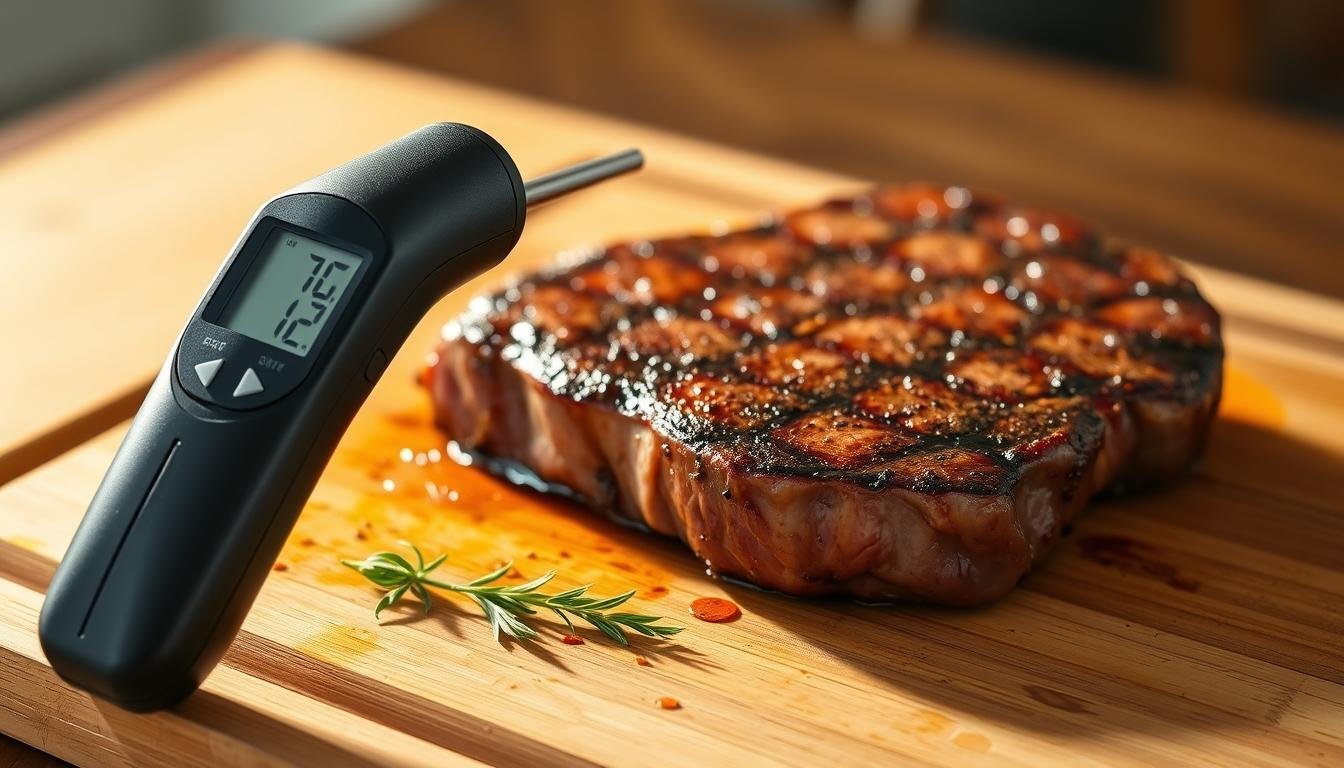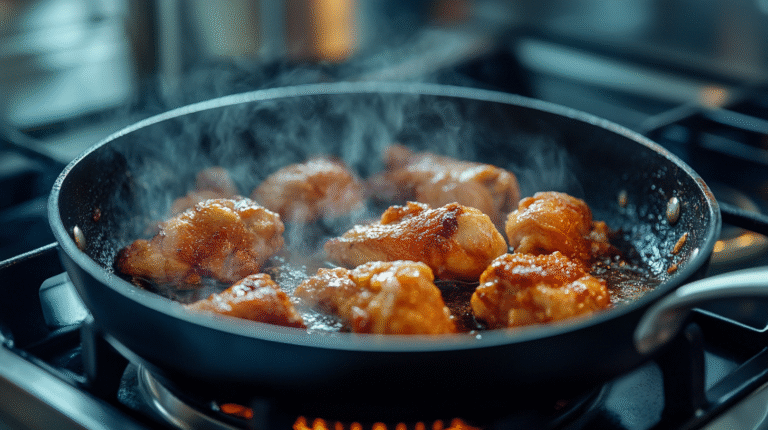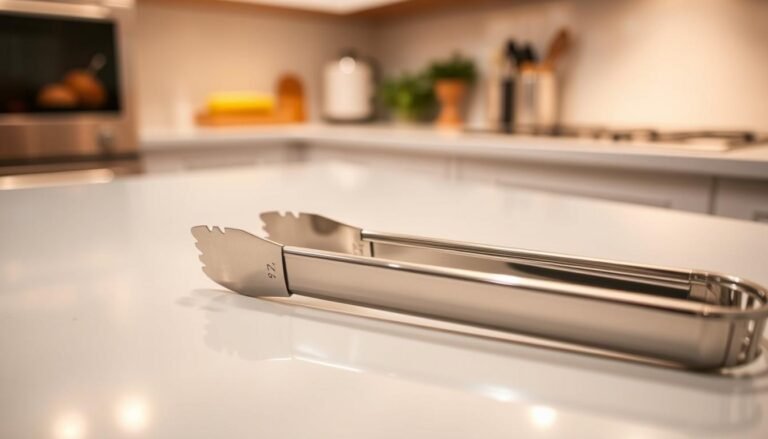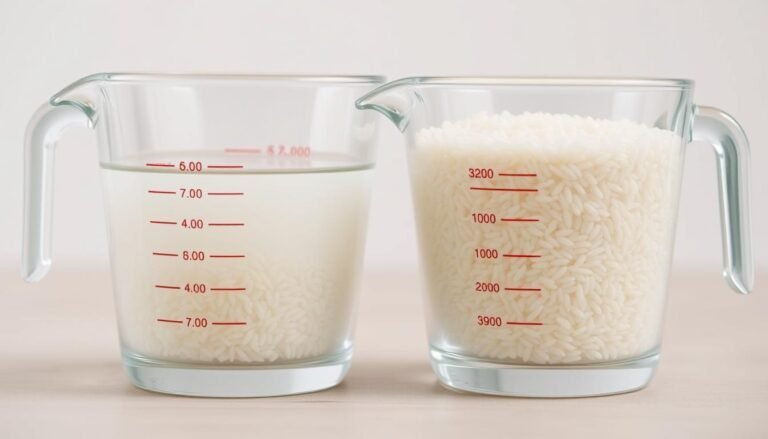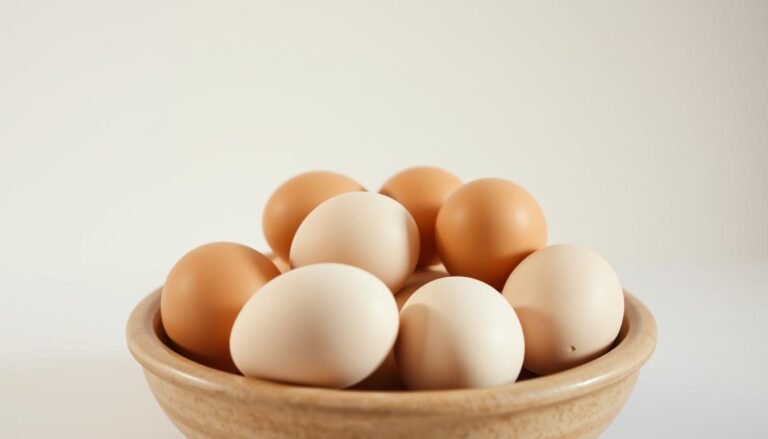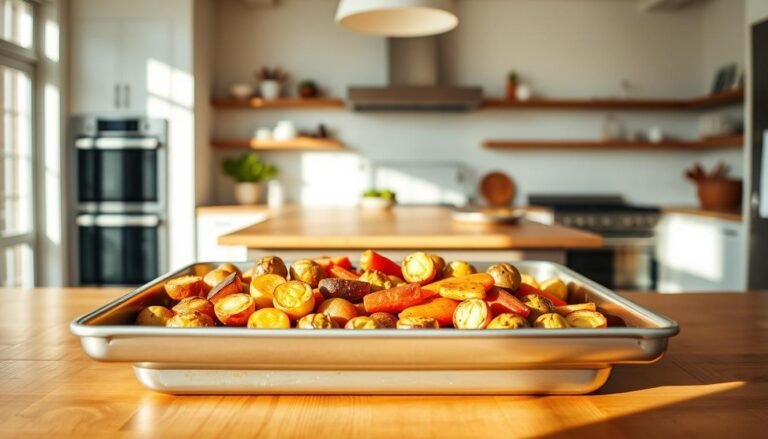Disclosure: This Post Contains Affiliate Links; We earn a commission on purchases.
Cooking meat safely is key to avoid foodborne illnesses. Whether you’re grilling steak or searing chops, knowing when it’s done is vital.
To keep meat safe, follow the right cooking steps. Safefood.net says using a meat thermometer is the best way to check if meat is cooked right.
Key Takeaways
- Use a meat thermometer to check internal meat temperature.
- Cook poultry and pork to an internal temperature of at least 75°C.
- Avoid eating undercooked or raw meat, specially for vulnerable people.
- Ensure juices run clear when piercing the thickest part of the meat.
- Cut into the meat to verify it’s piping hot and steaming throughout.
The Importance of Properly Cooked Meat
Cooking meat right is very important for our health. It kills harmful bacteria that can make us sick. All raw meats can have these bad bugs, so cooking them well is key.
Health Risks of Undercooked Meat
Meat that’s not cooked enough can be very dangerous. Bacteria like Salmonella and E. coli can make us very sick. This can lead to diarrhea, stomach pain, and throwing up.
In serious cases, it can even be deadly. This is true for older people, young kids, and those with weak immune systems.
Common Foodborne Pathogens in Meat
Raw meat can have Salmonella, E. coli, and Campylobacter. These germs can be on the meat’s surface or inside. Cooking meat well is the best way to kill these germs and make it safe to eat.
For more info on checking if meat is cooked right, check out this resource.
Balancing Safety and Flavor
It’s important to make meat safe and tasty. Cooking it too long can make it dry and flavorless. Cooking it too short can be unsafe.
Using a meat thermometer helps. It makes sure the meat is cooked just right. This way, we can enjoy the meat’s natural taste and texture.
Using a Meat Thermometer: The Most Reliable Method
A meat thermometer is the best way to check if your meat is cooked right. It makes cooking easy and safe. You’ll know your meat is ready just the way you like it.
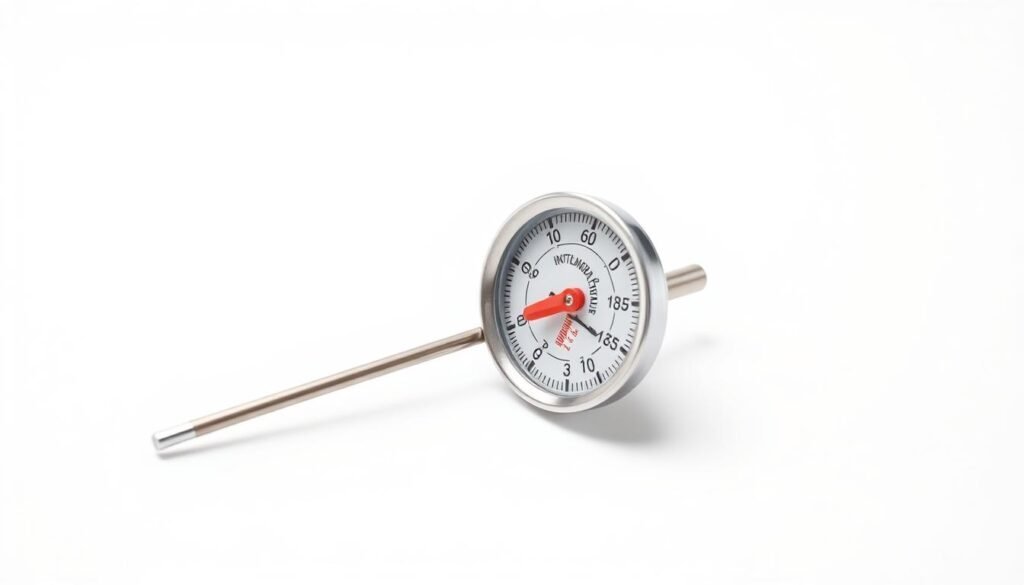
Digital vs. Analog Thermometers
You can pick between digital and analog meat thermometers. Digital thermometers are fast and accurate. Analog thermometers are cheaper and don’t need batteries.
Instant-Read vs. Leave-In Thermometers
Meat thermometers come in two types: instant-read and leave-in. Instant-read thermometers show the temperature quickly. Leave-in thermometers stay in the meat to watch the temperature all the time.
How to Calibrate Your Thermometer
To get accurate readings, calibrate your thermometer. Put it in ice and water; it should say 32°F (0°C).
Proper Thermometer Placement Techniques
Where you put the thermometer matters. Stick it in the thickest part of the meat. But avoid fat and bone.
Cleaning and Maintaining Your Thermometer
Wash your thermometer with soap and water after each use. Dry it well to stop bacteria from growing.
By using a meat thermometer, you’ll cook meat safely and perfectly every time. It makes your kitchen safer and your meals better.
Safe Internal Temperature Guidelines for Different Meats
It’s very important to make sure meat is cooked to a safe temperature. This helps avoid getting sick from food. Each type of meat has its own safe temperature to cook at.
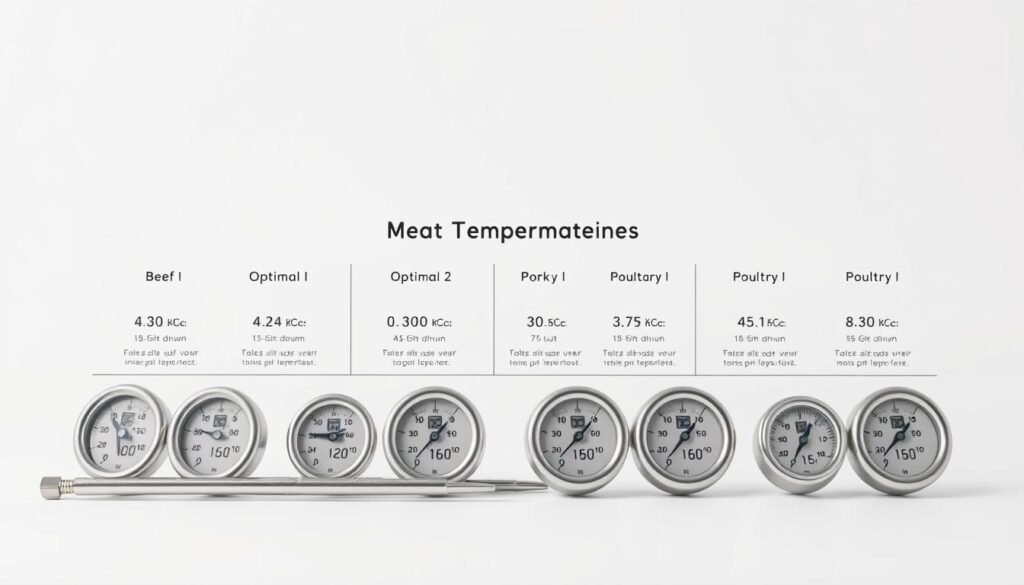
Poultry Safety Temperatures
Poultry, like chicken and turkey, needs to be cooked to 165°F. This rule applies to all parts of the bird, like breasts, thighs, and wings.
Beef, Veal, and Lamb Doneness Levels
Beef, veal, and lamb should be cooked to at least 145°F. The doneness level can be checked by the internal temperature. 145°F is medium-rare, and 160°F is medium.
Pork and Ham Safety Guidelines
Pork and ham must be cooked to 145°F. This kills harmful bacteria, making the meat safe to eat.
Ground Meat Safety Concerns
Ground meats, like beef, pork, and lamb, need to be cooked to 160°F. Ground poultry should be cooked to 165°F.
Fish and Seafood Temperature Guidelines
Fish should be cooked to 145°F. For shellfish, like shrimp and lobster, they should be opaque and firm. But, it’s best to check the internal temperature too.
Using a meat thermometer is the best way to check if meat is cooked safely. By following these guidelines, you can enjoy your meals safely and avoid getting sick.
How Can I Tell If Meat Is Cooked Safely at Home Without a Thermometer?
Cooking meat safely is key, and you can do it without a thermometer. You can use simple techniques. While thermometers are the most accurate, other methods can help when you don’t have one.
Visual Indicators for Different Meats
Meat shows different signs when it’s cooked. For example, chicken is done when its juices are clear and it’s not pink anymore. Beef changes color too: rare is red in the middle, and well-done is brown all over. Here are some visual signs to look for:
- Chicken and turkey: Juices run clear, no pink color
- Beef: Color changes from red (rare) to brown (well-done)
- Pork: Firm to the touch, white or slightly pink color
The Touch Test Method
The touch test is about feeling the meat to see if it’s done. Firmer meat is usually more cooked. For example, a rare steak feels soft, while a well-done one feels hard. It takes practice to get good at this.
Juice Clarity and Color Assessment
Looking at the juices can also tell you if meat is cooked. For chicken, clear juices mean it’s done. For red meats, the juice color changes from red (rare) to brown or clear (well-done). Here’s how to check juice clarity:
- Cut into the thickest part of the meat
- Observe the color and clarity of the juices
- Compare to known indicators of doneness
Limitations of Non-Thermometer Methods
These methods have their limits. Visual cues and the touch test can be tricky and not always right. So, using a thermometer is the best way to make sure meat is cooked safely.
Common Mistakes When Checking Meat Doneness
Cooking meat to the perfect doneness is a challenge. It’s key for food safety. Many home cooks make mistakes, leading to undercooked or overcooked meat. Knowing these errors helps cook meat perfectly every time.
Relying Solely on Cooking Time
One big mistake is only using cooking time. Cooking time changes with meat size, thickness, and method. Using a timer alone can lead to undercooked or overcooked meat. Mix methods to check doneness.
Cutting Into Meat Prematurely
Cutting into meat too soon can make it dry. It’s important to resist checking too often. Let it cook longer for better juices.
Misjudging Color as a Reliable Indicator
Color isn’t always right for doneness. Meat can look cooked outside but be raw inside. Use internal temperature or touch test too.
Ignoring Carryover Cooking
Carryover cooking happens when meat cooks after being removed. Ignoring this can make meat overcooked. Remove meat a few degrees before the desired temperature.
Forgetting to Rest Meat After Cooking
Not resting meat after cooking can make it tough. Resting meat makes it tender and juicy. Always rest meat for a few minutes before serving.
Special Considerations for Different Cooking Methods
Each cooking method needs its own special way to cook meat safely. Different ways of cooking can change how heat spreads in the meat. This might cause parts to be undercooked or overcooked if not done right.
Grilling and Direct Heat Methods
Grilling can trick you with the meat’s outside color. A steak or chicken breast might look cooked because of grill marks. But, it could be cold inside. A meat thermometer guide helps make sure the meat is safe to eat.
Roasting and Baking Techniques
Roasting and baking cook meat in the oven. Heat goes all around the meat. It’s key to use a thermometer and turn the meat sometimes for even cooking.
Slow Cooking Safety Guidelines
Slow cookers cook meat slowly for a long time. It’s important to make sure the meat gets to a safe temperature. This is usually 165°F for chicken and 145°F for beef, pork, and lamb.
Sous Vide Temperature Precision
Sous vide cooking seals meat in a bag and cooks it in water at a set temperature. This method lets you control the temperature exactly. It makes sure the meat is cooked evenly.
Smoking and Low-Temperature Cooking
Smoking and low-temperature cooking are tricky because they cook meat slowly. It’s very important to use a thermometer. This ensures the meat is cooked safely.
Conclusion: Ensuring Safe and Delicious Meat Every Time
It’s very important to cook meat right for a safe and fun meal. By following the tips in this article, you can make tasty meals safely at home.
Using a meat thermometer is the best way to check if meat is done. But, knowing how to look at the meat and other methods can also help.
Knowing about common mistakes and how to avoid them is key to meat safety. This way, you can enjoy your meals without worry.
By using these tips, you can always make safe and tasty dishes. This makes mealtime a joy for everyone.
FAQ
What is the most reliable way to check if meat is cooked safely?
How do I use a meat thermometer correctly?
What are the safe internal temperatures for different types of meat?
Can I check if meat is cooked safely without a thermometer?
What are common mistakes when checking meat doneness?
Are there special considerations for different cooking methods?
How can I ensure my meat is cooked safely and deliciously every time?
What are some meat safety tips for home cooking?

With over a decade of experience turning everyday ingredients into reliable, crowd-pleasing meals, Ryan knows firsthand the frustration of wasting time and effort in the kitchen. He specializes in clear, no-fuss guidance—breaking down techniques, time-saving tips, and smart shortcuts so that even complete beginners feel empowered and confident.
Subscribe to Our Newsletter

